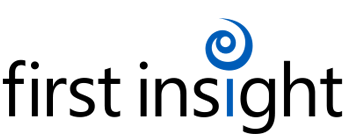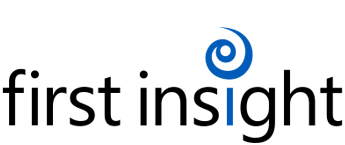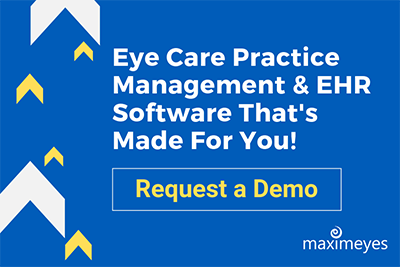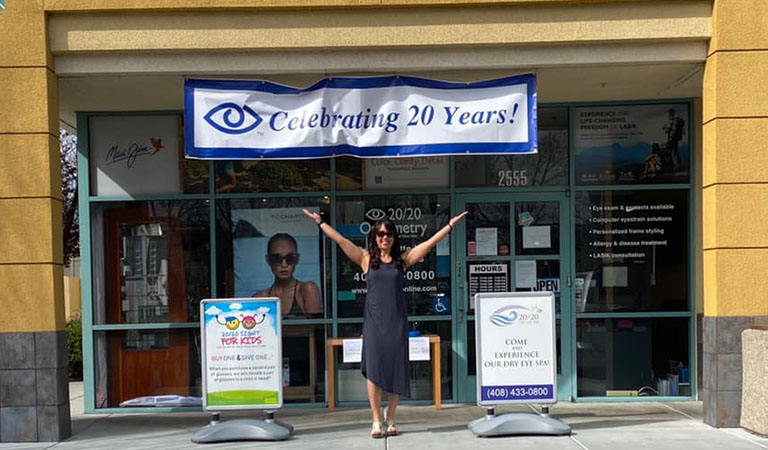
14 May Reopening an Eye Care Practice During COVID-19
COVID-19 is changing the way eye care professionals manage their practice and provide patient care. For Jeanette Lee, OD, owner of 20/20 Optometry of Silicon Valley in San Jose, CA, when NorCal Santa Clara County issued a shelter-in-place order in March 2020, her priority was to set a plan in motion so her practice would continue taking care of patients, first responders, and essential service workers.
Dr. Lee never wanted to close her optometry practice entirely during the shelter-in-place as she felt a strong commitment to the community. Luckily, her team is by her side for the long haul. Her staff helped alleviate eye care emergencies in overwhelmed hospitals by providing a safer, less hectic place for patients to get urgent and emergent eye care.
A Jobson Optical Research coronavirus ECP survey reports that 93% of eye care professionals are planning to reopen as restrictions ease in many states. See how Dr. Lee kept her optometry practice running efficiently with reduced office hours during the stay-at-home/shelter-in-place, and how she is reopening her office while adhering to COVID-19 health protocols and patient flow processes.
Managing an Office During the COVID-19 Shelter-in-Place
What immediate changes did you make during the shelter-in-place order?
On March 17, 2020, we reduced our office hours to 10:00 am to 2:00 pm, Monday through Friday, eliminating weekends. We were open for urgent and emergencies only—most were done via telehealth and telemedicine. In early April we increased our office hours to 10:00 am to 5:00 pm, Monday through Thursday, and 10:00 am to 2:00 pm on Friday.
We approached these reduced hours as a proactive opportunity to revise office policies and procedures, and find ways we could safely provide care to our patients.
We called patients to ask if they needed more contact lenses, especially those we rescheduled appointments. Many patients were happy that we called to check to see if they needed anything. We were recalling hundreds of patients that did not have appointments this year and who did not have an eye exam for two years. We were also selling contact lenses the entire time and renewing prescriptions on a case-by-case basis.
ABB Optical Group, our contact lens distributor, supported optometric practices by offering free shipping with the order of two boxes of disposable contacts. Patients appreciated the free shipping and being able to stay at home to maintain safety measures.
A number of patients were suffering from severe dry eyes due to allergies or eye strain from extended computer use from the “Shelter in Place.” Treatment for dry eyes was administered at our Dry Eye Spa to our patients who were in pain and were impaired from performing daily activities. We also sent eye care products to many of our patients who needed supplies for maintaining their dry eyes.
How are you communicating with your patients during COVID-19?
We use Demandforce (which integrates with our practice management system) to deploy weekly news, product offerings, and critical updates about COVID-19 to patients via email. I could not have survived without Demandforce as their COVID-19 tools and resources help me stay connected with my patients.
We also use social media as a quick and easy way to get information out. My website consultants, who specialize in SEO, updated our website once a week or as changes occurred.
What types of telehealth and telemedicine services did you provide to your patients?
Most of the telemedicine services we provided were for infections, inflammation, and allergies. A few were for computer glasses, which I can fabricate based on their existing prescription.
Since CMS relaxed telehealth reimbursement rules and the Department of Health and Human Services (HHS) is allowing the use of “everyday communication technologies” during COVID-19, we used FaceTime, Zoom, and WhatsApp for telemedicine consultations and virtual frame selection.
Having various technology options, with the ability to log in to our cloud-based optometry EHR (MaximEyes) and document patient records remotely, made our practice more efficient.
What staff changes did you initially make when you reduced office hours?
We had one high-risk staff manager and a few who chose to remain at home during the shelter-in-place. Our full-time optician and front desk manager stayed with me for our reduced schedule. My two part-time optometric techs filled in the gap and worked in the afternoons to not overlap with the front desk person, so I had an optometric assistant every day.
Our desks were all 8 feet or more apart in the office and we adhered to social distancing the entire time. We wore masks if patients were in the office. Since we rescheduled all our patient appointments, I furloughed our part-time doctors since there were no patients to see. I have been the only doctor in the office.
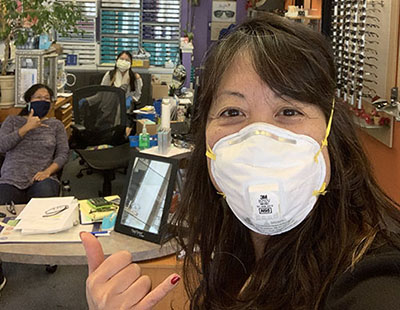
How are you supporting and motivating your staff during COVID-19?
I am blessed and thankful that my team supports each other during this healthcare crisis. The ones that are with me at the office, I talk with them daily on how we can continue making the practice stay afloat. I’ve been emailing other staff about different webinars and CE (for doctors) so they can remain educated and up-to-date.
Everyone knows they still have a job, but we have to understand the new landscape to allow their employment to be fruitful. The staff is aware that I have applied for small business loans, but if needed, I will put in my personal money to keep the practice running.
Planning for a Safe Practice Reopen After Shelter-in-Place Ends
When did you reopen for routine eye care?
Beginning May 4, NorCal Santa Clara County allowed eye care practices to reopen as an essential business and provide comprehensive eye exams as long as we complied with CDC and local/state regulations.
Why did you and your staff get tested for the COVID-19 antibody?
While my staff and I didn’t have any symptoms, I bought the COVID-19 antibody test kits to show if we were healthy. We all tested negative for the COVID-19 antibody, which means we were not infected or have been infected in the past. What I did not expect is the peace of mind my entire team had after they took the test and received the results: PRICELESS.
What COVID-19 safety precautions and patient flow processes are you using in your practice?
Doors to enter the office remain locked and patients must call us to let them in the office. Patients will wait in their car and we will call them when a staff member or doctor is ready to see them.
Exam appointments are spaced an hour apart to prevent overcrowding. Only the patient with a scheduled appointment is allowed in the office, unless the accompanying person is necessary for communication purposes or if the person is accompanying a minor.
Curbside service for glasses and contact lens pick-up is available. Couriers and postal workers will leave packages outdoors when our office is open.
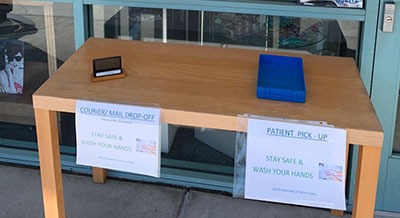
Some of the chairs have been removed in the waiting room to adhere to social distancing. All non-essential papers like brochures, magazines, calendars, etc. were removed from the waiting room. There is only a Kleenex box sitting on the table.
Patients are required to use hand sanitizers once they walk in. We check patient temperatures using an infrared forehead thermometer. We ask each patient if they have symptoms of illness, fever, or flu-like symptoms, and if they have been exposed to anyone with COVID-19 in the last 2–14 days.
A face covering or mask is required for all people who enter our office. If they don’t have a face mask, we offer disposable masks available for purchase. We also sell Hawaiian print face masks from the Big Island (available in 8 designs) and an anti-fog solution. Staff always wear masks and gloves while working, unless the gloves get in the way with specific tasks.
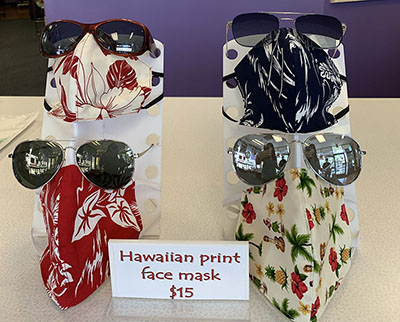
Patients must sign in and complete the online patient welcome form unless they make an appointment right away and don’t have the time. If patients don’t know how to use mobile devices (very rare), we have sanitized pens on the counter marked “clean” and “dirty” to separate the pens when filling out paperwork.
If the check-in iPad is used, we are using a stylus for patients to sign the necessary forms for our office policies. The stylus pens are separated into a “clean and dirty pile.” The Check-in App automatically syncs patient data with my optometric EHR software.
The techs will take a quick case history during pre-testing, but the doctors will take more time during the eye exam so that the patients don’t linger outside of a room. We are also tracking the time of day that people come into the office for contact tracing.
Plexiglass barriers were installed to block the front desk person from the patient. Our creative optical manager added a protective plastic shield to the digital pupillometer. A slit lamp and an extension protection shield were also added to the examination room.
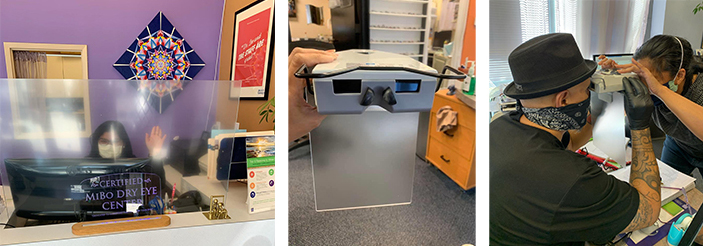
Signs are displayed in the optical areas that say “look and do not touch” for selecting and trying on a frame. Dirty frames are placed in trays and we move them aside to sanitize them.
The entire office (including chairs and table desktops) is disinfected multiple times during the day. Any surface, equipment, or chair touched by a patient is disinfected immediately after the exam with alcohol.
A fogging system sprays the air in the entire office to sanitize the surface of the floor and products to inactivate the coronavirus within 10 minutes of spraying.
COVID-19 Industry Resources For Reopening Your Practice
- Ready for routine care? AOA offers guidance for post-COVID-19 reactivation (AOA)
- Webinar: Practice Reactivation, Telehealth, and Relief Efforts for ODs (AOA)
- Webinar: Practice Reopening Guidance (AOA)
- Environmental Cleaning and Disinfection Recommendations (AAO)
- Reopen Eyecare: Guide to Getting Back to Business (Sponsored by The Vision Council)
- Re-Opening Facilities to Provide Non-emergent Non-COVID-19 Healthcare Phase 1 (CMS)
- MOA Cautions Against Avoidable ER Visits for Primary Eye Care Services During COVID-19 Pandemic (Daily Journal)
- 20 Tips For Reopening Amid COVID-19 (Review of Optometry)
- Optometric Survival Series Part III: How to Reopen Your Practice (Review of Optometric Business)
- 14 Instructional (or Even Inspiring) COVID-19 Signs to Consider When Your Business Reopens (Invision Magazine)
- Cleaning and Disinfecting Your Facility (CDC)
- Information on Disinfectants and Coronavirus (EPA)
- Guidance for Cleaning and Disinfecting Public Spaces, Workplaces, Businesses, Schools and Homes (EPA)
- Workplace Safety Poster and Information (OSHA)
- COVID-19 printable flyers and fact sheets for your office (CDC)
- How to Clean Hands Poster and Health Promotion Materials (CDC)
- Wholesale Supplier for Eye Care Professionals (Ophthalmics, Inc.)
MaximEyes optometric practice management and EHR software is an industry-leading solution for eye care professionals. Request a demo and see if MaximEyes is right for your eye care practice.
